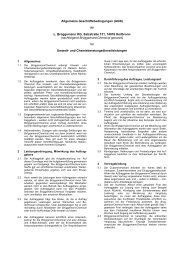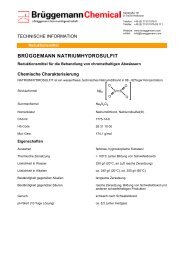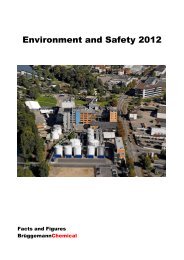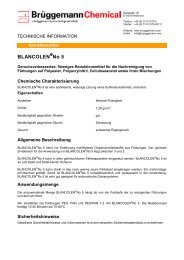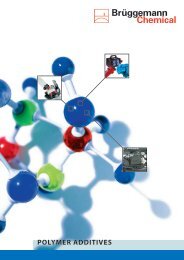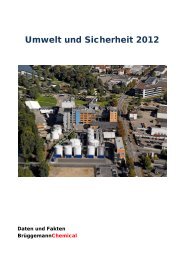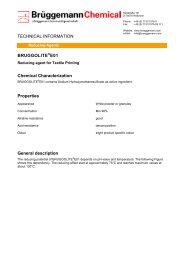Sodium Hydrosulfite S
Sodium Hydrosulfite S
Sodium Hydrosulfite S
You also want an ePaper? Increase the reach of your titles
YUMPU automatically turns print PDFs into web optimized ePapers that Google loves.
TECHNICAL INFORMATION<br />
~<br />
Reducing Agents<br />
SODIUM HYDROSULFITE<br />
Reducing Agent for Treatment of Chromium(VI)-containing Sewage<br />
Chemical Characterization<br />
BRUGGEMANN SODIUM HYDROSULFITE conc. powder is sodium dithionite, whose activity is between<br />
88 and 92%.<br />
O O<br />
Chemical structure Na2 S S<br />
Empirical formula Na 2 S 2 O 4<br />
Nomenclature sodium dithionite, sodium disulphate(III)<br />
CAS-Number 7775-14-6<br />
Formula weight 174,1 g/mol<br />
HS-Code 28 31 10 00<br />
Properties<br />
Appearance colourless, deliquescent substance<br />
Decomposition point > 100°C (formation of sulphur dioxide)<br />
Solubility in water (20°C) 230 g/l , in the presence of air fast decomposition<br />
Solubility in alkalies approx. 240 g/l (20°C), approx. 350 g/l (60°C)<br />
Alkali resistance slow decomposition<br />
Acid resistance immediate decomposition, formation of sulphur dioxide<br />
and other sulphur compounds<br />
Odour slight sulphur dioxide odour<br />
pH-value (100 g/l, 20°C) approx. 8,5 (inert gas atmosphere)<br />
O<br />
Salzstraße 131<br />
D-74076 Heilbronn<br />
Phone: +49 (0) 7131/1575-0<br />
Fax: +49 (0) 7131/1575-25 111<br />
Website: www.brueggemann.com<br />
e-Mail: info@brueggemann.com<br />
O
General Description<br />
Technical Information <strong>Hydrosulfite</strong> Galvanic .doc<br />
BRUGGEMANN SODIUM HYDROSULFITE contains 88 to 92% sodium dithionite. The reduction capacity of<br />
sodium dithionite depends on the pH-value. Although the reduction capacity in acid area is much higher than<br />
in alkaline, the reduction of chromium(VI) in alkaline medium is successful.<br />
Under these conditions dithionite is oxidized to sulphite by handing over two electrons (1):<br />
(1)<br />
2-<br />
S2O4 + 4 OH -<br />
2<br />
SO 3<br />
-<br />
2<br />
+ 2e -<br />
+<br />
2 H 2O<br />
In weakly alkaline to neutral area the oxidation proceeds up to the dithionate (2):<br />
(2)<br />
2-<br />
S2O4 + 4 OH -<br />
2<br />
S 2O 6<br />
2-<br />
+ 4e -<br />
+<br />
2 H 2O<br />
In acid solution dithionite is oxidized by the dichromate up to the sulphate (3):<br />
2-<br />
(3) S2O4 + 4 H2O 2<br />
- +<br />
HSO4 + 6 H<br />
+ 6e -<br />
The reaction sequences (4) – (6) show, that the consumption of dithionite for the reduction of chromium (VI)<br />
is greatly dependent on the pH-value.<br />
alkaline medium:<br />
(4)<br />
2<br />
2-<br />
CrO4 2-<br />
+ 3 S2O4 weakly alkaline to neutral medium:<br />
2-<br />
CrO4 2-<br />
2-<br />
+ 2 H2O 2 Cr + 6 SO3 3+<br />
4 + 3 S2O4 + 10H2O 4 Cr + 3<br />
3+<br />
(5) S2O6 acid medium:<br />
2-<br />
2-<br />
Cr2O7 + S2O4 +6 H 2 Cr + 2<br />
3+<br />
(6) SO4 +<br />
2-<br />
2-<br />
+ 4 OH -<br />
+<br />
+<br />
20 OH -<br />
3 H2O The consumption of dithionite can not be exactly determined by stoichiometric calculations. The exact<br />
dosage rate should be determined by a laboratory test.<br />
In comparison to the traditional chromium(VI) reduction by bisulfite with the application of sodium dithionite<br />
no acidification below pH 2,5 is necessary. Therefore no additional quantities of acid and alkali for the<br />
neutralisation must be inserted. The unnecessary entry of salting in the sewage can be avoided.<br />
By the usage of SODIUM HYDROSULFITE the weakly acid pH-value of the chromium(VI)-containing<br />
sewage is sufficient. SODIUM HYDROSULFITE is therefore the current and environmental friendly<br />
reducing agent for the sewage treatment.<br />
Furthermore SODIUM HYDROSULFITE is best suit for the reduction of chromium(VI) in cyanide-containing<br />
sewage. In this case cyanide is oxidized in strong alkaline medium and afterwards reduced by SODIUM<br />
HYDROSULFITE in still alkaline solution.<br />
Safety advice<br />
Safety data and information can be taken from the Material Safety Data Sheet<br />
2
Technical Information <strong>Hydrosulfite</strong> Galvanic .doc<br />
Package, delivery and storage<br />
50 kgs polylined iron drums<br />
100 kgs polylined iron drums<br />
1000 kgs returnable containers (only SODIUM HYDROSULFITE S)<br />
1200 kgs returnable containers (only SODIUM HYDROSULFITE N)<br />
BRUGGEMANN SODIUM HYDROSULFITE can be delivered as SODIUM HYDROSULFITE N (standard<br />
quality) and SODIUM HYDROSULFITE S (reduced dust).<br />
If kept properly in unopened drums or containers (dry/25°C) the shelf life of BRUGGEMANN SODIUM<br />
HYDROSULFITE conc. powder is at least 12 months.<br />
<strong>Sodium</strong> <strong>Hydrosulfite</strong> must not be stored together with oxidizing substances or with acids.<br />
~<br />
Technical Information <strong>Hydrosulfite</strong> Galvanic Version dated 01.10.2009<br />
The information given herein and otherwise supplied to users is based on our general experience and, where applicable on the results of tests on samples<br />
of typical manufacture. However, because of the many factors which are outside our knowledge and control which can affect the use of these products, we<br />
cannot accept liability for any injury, loss or damage resulting from reliance upon such information.<br />
3



